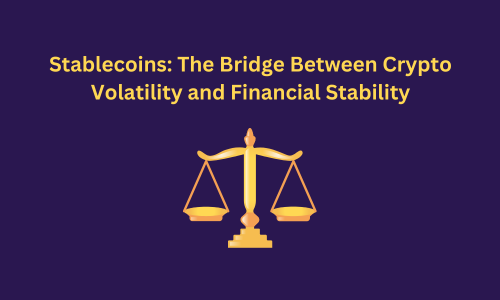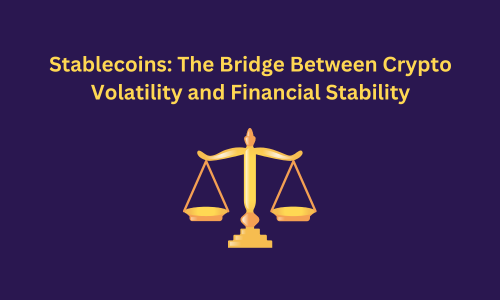


Cryptocurrencies have revolutionized how we think about money, offering decentralized and borderless alternatives to traditional finance. However, their wild price swings have limited their usefulness for everyday transactions and savings. Enter stablecoins — a type of cryptocurrency that aims to combine the benefits of blockchain technology with the stability of fiat currencies. In this article, we’ll explore what stablecoins are, why they’re pegged to other assets, and how they offer a unique advantage over regular cryptocurrencies.
Stablecoins are digital currencies designed to maintain a consistent value by being pegged to stable assets like the US dollar, other fiat currencies, or even commodities like gold. Unlike traditional cryptocurrencies like Bitcoin or Ethereum, whose prices can fluctuate drastically within a short period, stablecoins aim to minimize volatility and provide a reliable store of value.
This price stability makes them attractive for a variety of use cases, from facilitating seamless global transactions to serving as a safer option for holding value in decentralized finance (DeFi) applications.
The key feature of stablecoins is their “peg” — a mechanism that links the value of the coin to a stable external asset. There are four primary types of stablecoins, each pegged differently:
Fiat-Collateralized Stablecoins: These are backed by fiat currencies held in reserve. For example, USDC and USDT (Tether) are pegged to the US dollar, meaning each token is supposed to be redeemable for one dollar. The reserves are audited to ensure there’s sufficient backing for the issued tokens.
Crypto-Collateralized Stablecoins: Instead of fiat currency, these stablecoins are backed by other cryptocurrencies. Since cryptocurrencies are inherently volatile, these stablecoins are often over-collateralized to provide a buffer. DAI, for instance, is pegged to the US dollar but backed by Ethereum and other assets locked in smart contracts.
Commodity-Collateralized Stablecoins: These stablecoins are pegged to commodities like gold or silver. An example is PAX Gold (PAXG), which is backed by physical gold reserves held in custody by regulated institutions. Each PAXG token represents one fine troy ounce of gold stored in a secure vault. The benefit of gold-backed stablecoins is that they offer exposure to the price of a valuable, tangible asset while still enjoying the benefits of digital currencies, such as fast and low-cost transactions.
Algorithmic Stablecoins: These stablecoins use algorithms and smart contracts to control supply and demand, maintaining their peg without holding actual reserves. When the price rises above the peg, new tokens are minted, and when it falls, tokens are removed from circulation. However, this model can be risky and has led to notable failures, such as the collapse of TerraUSD.
The primary reason for pegging stablecoins to external assets is to counteract the volatility that plagues traditional cryptocurrencies. Cryptos like Bitcoin are speculative in nature, and their prices can swing wildly based on market sentiment, macroeconomic factors, or regulatory news. While this volatility is attractive for traders, it poses significant risks for everyday transactions and savings.
For example, using Bitcoin for a cross-border payment could mean that by the time the transaction is completed, its value has dropped by 10%. This unpredictability makes traditional cryptocurrencies impractical for use in commerce or as a store of value. Stablecoins solve this problem by maintaining a steady value, providing the reliability needed for transactions and financial planning.
1. Price Stability
The most obvious advantage of stablecoins is their price stability. Stablecoins are designed to maintain a 1:1 ratio with the asset they’re pegged to, offering users the peace of mind that their holdings won’t suddenly lose value. This makes them ideal for situations where predictability is crucial, such as remittances or everyday purchases.
2. Ease of Use in Payments
With stablecoins, users can enjoy the fast, low-cost, and borderless nature of blockchain-based payments without worrying about price fluctuations. Sending USDC from one country to another is as quick as sending Bitcoin, but with the assurance that the value received will remain constant. This makes stablecoins an attractive alternative for global payments and remittances, bypassing the fees and delays associated with traditional banking systems.
3. Access to Decentralized Finance (DeFi)
Stablecoins have become the lifeblood of decentralized finance (DeFi) platforms. These digital assets allow users to lend, borrow, and earn interest without the risks associated with volatile cryptocurrencies. By using stablecoins like DAI, DeFi participants can generate yields and participate in financial activities without being exposed to large price swings.
4. Financial Inclusion
For people in regions with unstable currencies or limited access to banking, stablecoins can act as a digital store of value. They provide a way to preserve wealth in a stable currency while avoiding the fees and complications of traditional banking systems. Additionally, anyone with an internet connection can access stablecoins, empowering millions to participate in the global economy.
5. Reducing Speculation
Stablecoins reduce the speculative nature of cryptocurrency trading. While Bitcoin or Ethereum might be held in hopes of significant price increases, stablecoins are held for their predictable value, making them less risky. This makes them attractive for conservative investors or businesses that want to take advantage of blockchain technology without exposure to extreme market fluctuations.
Potential Drawbacks
While stablecoins provide a wealth of advantages, they are not without risks. Fiat-collateralized stablecoins, for instance, rely on centralized entities to hold reserves, which introduces trust issues. Users must trust that the company issuing the stablecoin is properly backing the tokens in circulation, and there have been concerns about transparency in some cases.
Additionally, algorithmic stablecoins, though innovative, have proven vulnerable to losing their peg. The collapse of TerraUSD in 2022 serves as a cautionary tale, highlighting the risks involved in such experimental financial systems.
Stablecoins are not just filling a niche role in the crypto world — they are becoming an essential part of the broader financial ecosystem. As they continue to gain adoption, they could serve as a critical bridge between the worlds of traditional finance and decentralized digital currencies.
Their utility in cross-border payments, digital finance, and as a reliable store of value will likely drive further adoption, and despite regulatory hurdles, stablecoins have the potential to reshape how we think about money in the 21st century.
Stablecoins represent the next phase of the cryptocurrency evolution, providing the stability and predictability that traditional cryptocurrencies lack. By pegging their value to stable assets, they offer a solution to the volatility problem, opening the door for real-world use cases like payments, savings, and lending. Whether you’re looking for a safer way to store digital assets or seeking to leverage decentralized finance without the risks of price swings, stablecoins are a powerful tool with immense potential.
Disclaimer: This article is provided for informational purposes only. It is not offered or intended to be used as legal, tax, investment, financial, or other advice.
